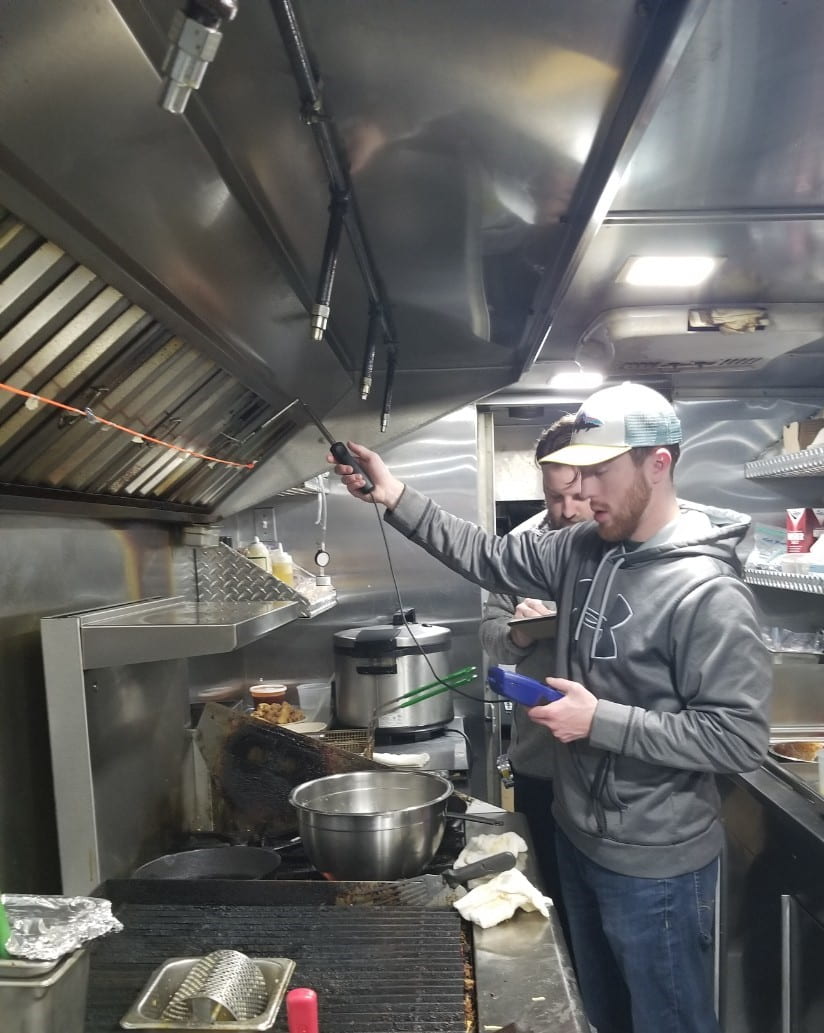Evaluation of Aldehydes, Polycyclic Aromatic Hydrocarbons, and PM2.5 Levels in Food Trucks
A Pilot StudyHolden Phillips, MPH and Jonghwa Oh, PhD
Background: The food truck industry has rapidly expanded in the United States and kitchen environments can contain harmful contaminants from cooking emissions. The objective of this study was to examine the levels of aldehydes, polycyclic aromatic hydrocarbons (PAHs), and Particulate Matter (PM) 2.5 generated from cooking process in food trucks.
Findings: Formaldehyde was the only aldehyde detected in all samples with a concentration range of 7.16 to 53.68 μg/m3. No PAHs were detected above the limit of quantification. Average PM 2.5 concentrations ranged from 0.65 to 7.03 mg/m3. Food Trucks 1 and 2 have an average exhaust flow rate of 211 and 215 L/s per linear meter of hood, respectively.
Methods: Area sampling was performed twice at two participating food trucks during work shifts. Nine aldehydes and eighteen PAHs were analyzed according to the relevant standard methods while PM 2.5 was measured with a real-time monitor. Ventilation performance of the food truck exhaust hoods was also investigated using a thermal anemometer.
Conclusions/Application to practice: Overall, Food Truck 2 had consistently higher levels of aldehydes and PM 2.5 with comparable ventilation performance as Food Truck 1. The higher exposure levels of Food Truck 2 could possibly be attributed to a larger volume of food orders and the heavy duty cooking equipment with an exhaust flow rate below the American Society of Heating, Refrigerating and Air-Conditioning Engineers (ASHRAE) recommendations. Although more investigations need to be performed, the findings could be used to raise awareness of food truck workers and health practitioners to reduce potential exposure risks.
Applying Research to Occupational Health Practice
The food truck industry in the United States has rapidly expanded in the past few years. Food truck environments are unique workplaces where workers use diverse thermal cooking appliances in a very limited space. In this pilot study, we examined the levels of contaminants generated through the cooking process within food trucks, including PM 2.5, aldehydes, and PAHs. In addition, the performance of the ventilation system of food trucks was also investigated. Our findings suggest potential exposure to formaldehyde and PM 2.5 with inadequate ventilation especially in a busier food truck, that is, higher emission and lower exhaust flow rate. Although more investigations need to be performed, the findings could be used to raise awareness of food truck workers and health practitioners to reduce potential risks of such exposures. Relatively simple engineering controls to improve the C&C efficiency of the existing ventilation system such as adding side panels to the hood and decreasing setback of the hood could be implemented wherever applicable.
AUTHOR BIOGRAPHIES
Holden Phillips, MPH is an industrial hygienist/safety technician at AMERICAN Cast Iron Pipe Company headquartered in Birmingham, Alabama. He earned an MPH degree at University of Alabama at Birmingham (UAB) with a focus on industrial hygiene in 2019.
Jonghwa Oh, PhD is an assistant professor in the Department of Environmental Health Sciences at UAB. She earned a PhD in environmental health sciences (industrial hygiene track) from UAB. Her main research area is on improving occupational exposure assessment and control methods.

Author’s Note: This study does not represent the views of the authors’ affiliations and its contents are solely the responsibility of the authors and do not necessarily represent the official views of National Institute for Occupational Safety and Health (NIOSH).
Funding: The author(s) disclosed receipt of the following financial support for the research, authorship, and/or publication of this article: This study was supported in part by The Deep South Center for Occupational Health and Safety (Grant #T42OH008436 from NIOSH).
ORCID iD: Jonghwa Oh https://orcid.org/0000-0002-6017-0963
Supplemental Material: Supplemental material for this article is available online.
